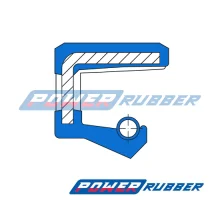Simeringi A
Type A oil seals are basic lip seals without a dust lip. They consist of an elastomeric outer shell, a metal sealing element, a lip with a spring for proper sealing against the shaft. Type A oil seals do not have an additional dust lip. They are used for sealing components of rotating or oscillating equipment (such as shafts, hubs, axles).
Simmering - what is it?
Simmering (also known as an oil seal) is a technical seal used to prevent leaks of oils and greases from components of machines and devices transmitting rotary or oscillatory motion (mainly shafts). The seal also prevents moisture and contaminants from entering from the outside (mud, dust, dirt).
The seal for rotary shafts consists of a rigid housing and a flexible sealing lip with a spring or without. Its construction can vary depending on the type.
Typical applications
At Power Rubber, radial shaft seals are manufactured from top-quality materials, ensuring proper sealing in a wide range of applications, such as:
- household appliances (dishwashers, washing machines)
- drive units (agricultural machinery, construction machinery)
- heavy-duty industrial machinery (wind turbine generators, rolling mills)
- engines (electric motors, internal combustion engines)
- gearboxes (industrial gearboxes)
- hydraulic units
- pumps
Rubber blends used for manufacturing oil seals
To produce sealing rings for rotary shafts of type A and AO, nitrile rubber (NBR), fluororubber (FKM/FPM), acrylic rubber (ACM), and silicone rubber (VMQ/MVQ) are most commonly used. Feel free to familiarize yourself with a brief characterization of each material, here it is:
NBR Rubber
The operating temperature range is from -40°C to +100°C. This type of rubber exhibits resistance to engine oils, gear oils, fuel oils, hydraulic fluids, oil-water emulsions, greases, and water.
ACM Rubber
The operating temperature range is from -20°C to +130°C. Acrylic rubber is compatible when in contact with engine oils, gear oils, and hydraulic fluids.
VMQ/MVQ Silicone Rubber
The operating temperature range is from -50°C to +150°C. Silicone rubber is characterized by its resistance to engine oils, gear oils, oil-water emulsions, and hydraulic fluids.
FKM/FPM Rubber
The operating temperature range is from -30°C to +180°C. This type of rubber is resistant to engine oils, gear oils, fuel oils, oil-water emulsions, hydraulic fluids, and synthetic fire-resistant fluids.
Type A and AO sealings that meet the following standards
PN-72/M-86964 - Rubber sealing rings for shafts with a metal reinforcing insert. Dimensions. PN-72/M-86965 - Sealing rings for shafts in a metal housing. Dimensions.
PN-88/M-73067 - Sealing rings for rotary shafts according to ISO. Nominal dimensions and tolerances.
PN-81/M-86960 - Rubber rings for sealing rotary shafts. Common requirements and tests
At Power Rubber company, we supply oil seals in accordance with strict quality requirements and standards. Our Simmer rings, among other things: ensure sealing of bearing nodes, prevent leaks of lubricating medium (both during operation and standstill), and protect machine and equipment components from the ingress of various contaminants.
PN-72/M-86964
The standard covers the dimensions of rubber sealing rings for shafts with a metal stiffening insert of type A, according to PN-66/M-86960
An example of the designation of the size of a type A Simmer ring according to the PN-72/M-86964 standard is presented below:
Sealing ring A 6x22x7 NBR, where:
d (nominal inner diameter of the ring) = 6 mm
D (nominal outer diameter of the ring) = 22 mm
b (ring height/thickness) = 7 mm
NBR – material type from which the Simmer ring is made
PN-72/M-86965
Standard PN-72/M-86965 specifies the dimensions of Simmer rings in an external metal housing of type B, according to PN-66/M-86960, used for sealing shafts.
Rotary shaft seals of type B are constructed with a single lip reinforced by a metal ring. The outer layer is not covered with elastomer.
An example of the designation of the size of a rubber ring in a metal housing according to the PN-72/M-86975 standard is presented below:
Sealing ring B 52x72x10 NBR, where:
d (nominal inner diameter of the ring) = 52 mm
D (nominal outer diameter of the ring) = 72 mm
b (ring height/thickness) = 10 mm
NBR – material type from which the Simmer ring is made
PN-88/M-73067
The standard PN-88/M-73067 covers the nominal dimensions and tolerances of sealing rings for rotary shafts according to ISO (International Organization for Standardization). The International Organization for Standardization ISO has introduced unified standards concerning, among others, the production of sealing rings for shafts
PN-81/M-86960
The standard covers common requirements and tests for rings with a rubber lip with a metal reinforcing insert or in an external metal housing or other construction according to technical documentation. Radial seals, also known as Simmer rings, are used for sealing rotary shafts at pressures not exceeding 0.02 MPa. This depends on the material from which the sealing ring for shafts is made and the temperature of the working environment. According to the above standard, in the case of shafts with a diameter above 200 mm, the recommended rotational speeds and peripheral speeds should be agreed between the manufacturer and the recipient.
Need type A and AO Simmer rings compliant with the above standards? Feel free to contact us.
